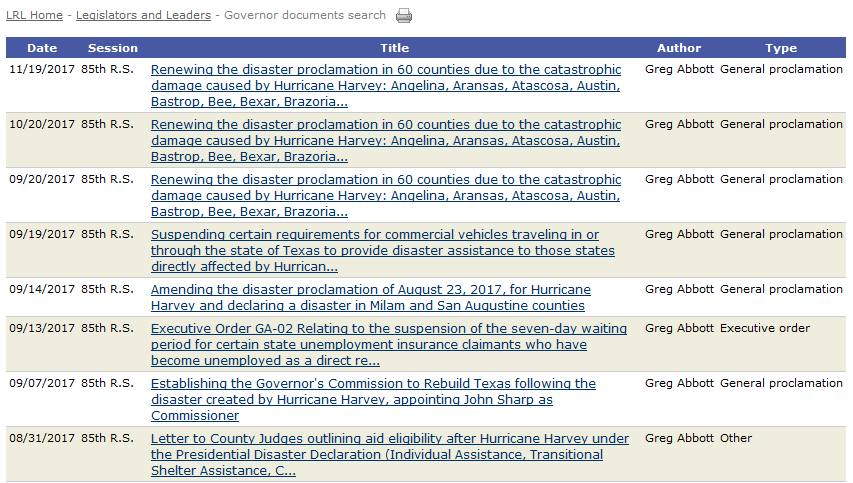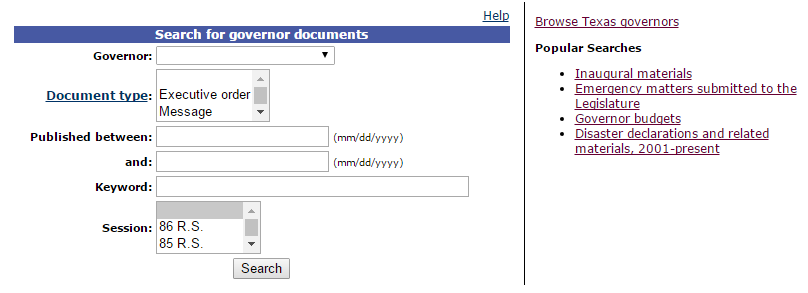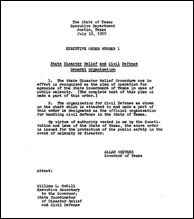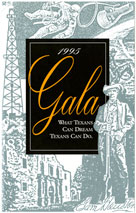Under the authority of Texas Government Code Chapter 418 and the state of disaster proclamation, Governor Abbott has worked with various agencies to waive regulations and guide Texas' response to COVID-19 (coronavirus).
You can access all of these proclamations and statements in our governor's database, where we have a link to COVID-19 documents listed with our "popular searches." The most recent additions are today's Governor's Executive Order No. GA-08 and the declaration of a public health disaster. The LRL will continue adding documents to the database as they are released.
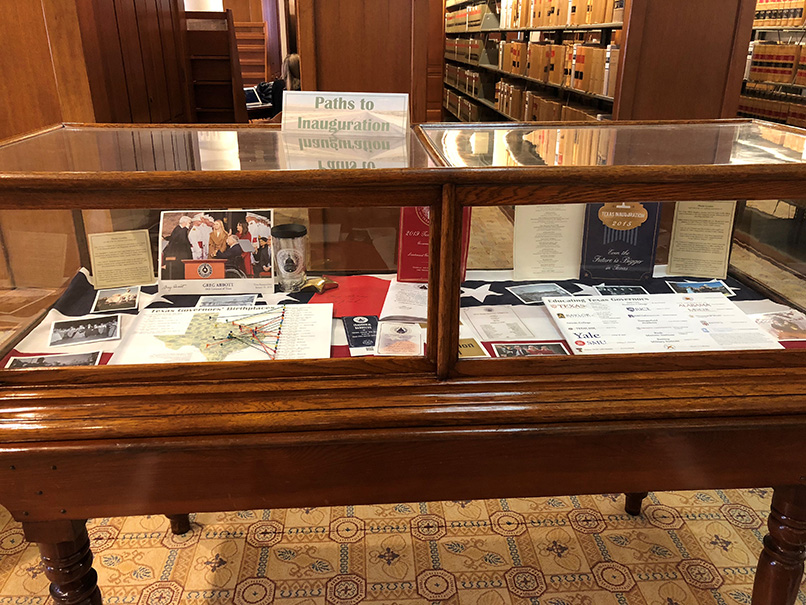
Learn a little about the backgrounds of Texas governors in our updated exhibit, Paths to Inauguration.
- View a thread map showing the birthplaces of all of the governors born in Texas—interestingly, only two out of twenty-one were born in the same town. (Rusk gave us both Gov. James Stephen Hogg, the first governor to be born in Texas, and Gov. Thomas Mitchell Campbell.)
- Consider the higher education institutes that helped prepare twenty-eight governors for leadership. (There are a lot more commonalities here than we saw in birthplaces!)
- Enjoy photos and other memorabilia from inauguration festivities, 1939 to 2019.
Cover image: The Ross Volunteer Company—a special unit in the Texas A&M Corps of Cadets that is the official Honor Guard of the Governor of Texas— escort Gov. Robert Allan Shivers and First Lady Marialice Shivers’ car as they head to the Capitol for the January 20, 1953, inauguration ceremony. Neal Douglass Photography Collection, Austin History Center, Austin Public Library.
Although our primary focus is on Texas' legislative branch, the LRL maintains a Texas Governors database with a myriad of resources. In addition to providing biographical information on Texas governors, 1846-present, it features a searchable database of executive documents. You can search by governor, document type (executive order, message, proclamation, speech, veto, and other), date of publication, keyword, and session.
To see the complete list of Texas governors with party affiliation, years in office, and legislatures as governor, click here.
We also have a few popular searches saved, making it easy to find inaugural items, the governor's emergency matters and budgets, and disaster declarations (from 2001-present) (see below).
Governor's Proposed Budget
Feb 13
You may have already seen the Comptroller's Biennial Revenue Estimate (BRE) and the House and Senate's respective appropriations bills. You also can view Gov. Abbott's proposed budget in the library's governors database by clicking on "governor budgets" in our popular searches.
Additional budget information is available on the library's state budget page.
State of the State Address
Jan 31
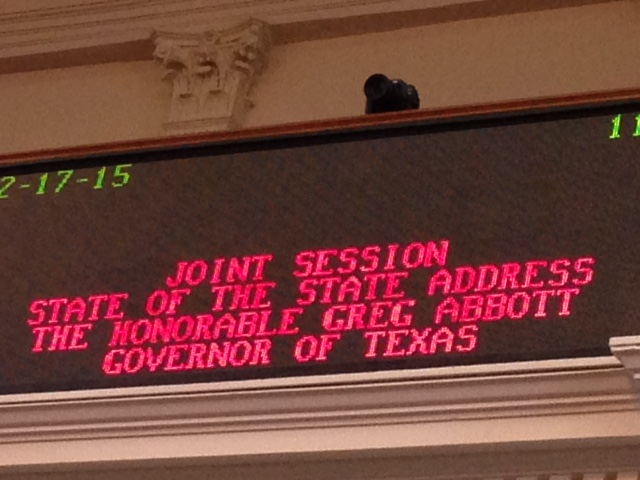
When Gov. Greg Abbott gives his "State of the State" address on January 31, he will carry on a long-standing tradition in Texas leadership, one that pre-dates statehood and governors. The Constitution of the Republic of Texas required the president to provide occasional updates on the state of the government and to recommend areas of attention to the legislature. The practice was carried on when Texas became a state, with the governor presenting the message, and continues to this day.
The governor's mandate, per the Texas Constitution, Article 4, Section 9, is to "give to the Legislature information, by message, of the condition of the State, and he shall recommend to the Legislature such measures as he may deem expedient." In the first State of the State message by Gov. J. Pinckney Henderson on February 24, 1846, his message is something of a to-do list for the newly annexed state. State leaders, from comptroller to United States Congressmen, needed to be elected as soon as possible. Texas needed a new tax system, to determine a way to provide for public schools, to organize judicial districts, and more.
Henderson gave his second State of the State message on December 15, 1847. (That year, Texas got two State of the State messages in December, since Henderson stepped down as governor, and George T. Wood took the position.) Henderson discusses what the Legislature had done to establish Texas as a state in their first year (and admonishes them for what wasn't completed), but also speaks at length about some current events—the Mexican War and "Indian affairs."
Indeed, these messages often begin with a broad overview of the current news, then use those events to lead in to discussion of specific issues. State of the State topics often are similar to those on the governor's campaign platform, especially if the governor has been recently elected. The address provides legislators with greater insight into the governor's goals for session.
The governor delivers the State of the State address to a joint session, at the Legislature's invitation. (See HCR 48, 84th R.S.) Of course, the general public also can view the speech via television, the Internet, etc., so the Governor's audience for the message is much wider than it used to be.
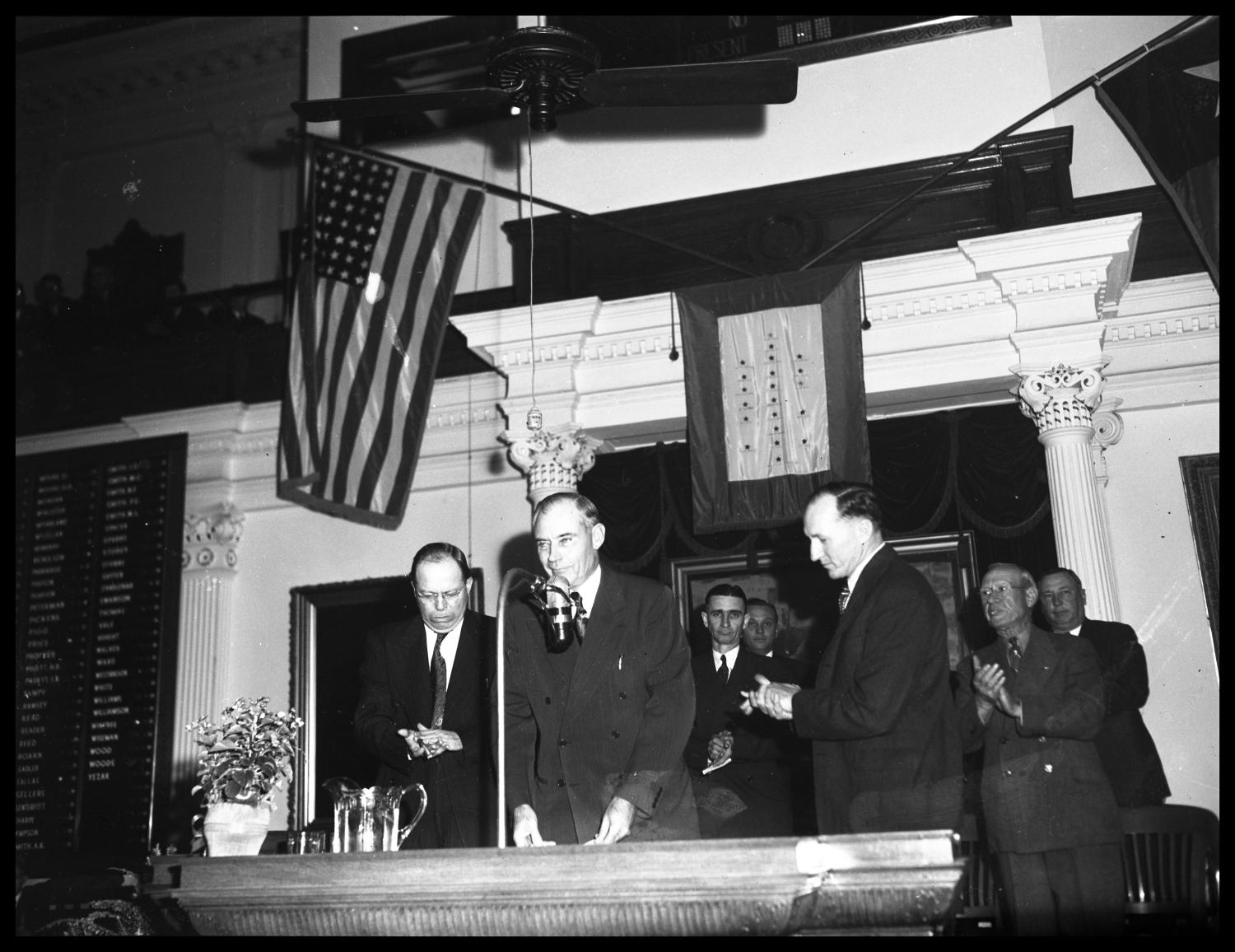
Today's "State of the State" messages from the governor are similar in many ways to Gov. Henderson's—describing the current health and well-being of Texas, and setting out what the governor sees as priorities that the Legislature ought to tackle to promote future prosperity. While the historical context surrounding the speech changes, themes like education, budget, and transportation (to name a few) recur again and again. The text of past State of the State addresses can be found in the library's governors database by searching for the phrase, "state of the state."
Images:
The screen in the House Chamber displays a welcome message to the members of the House and Senate gathered to hear the governor's message.
Gov. Coke R. Stevenson addresses the 49th Legislature on January 11, 1945. His speech largely looked toward post-World War II planning efforts. Neal Douglass Photography Collection, Austin History Center, accessed via the Portal to Texas History.
The screen in the House Chamber displays a welcome message to the members of the House and Senate gathered to hear the governor's message.
Governor's Emergency Items
Jan 30
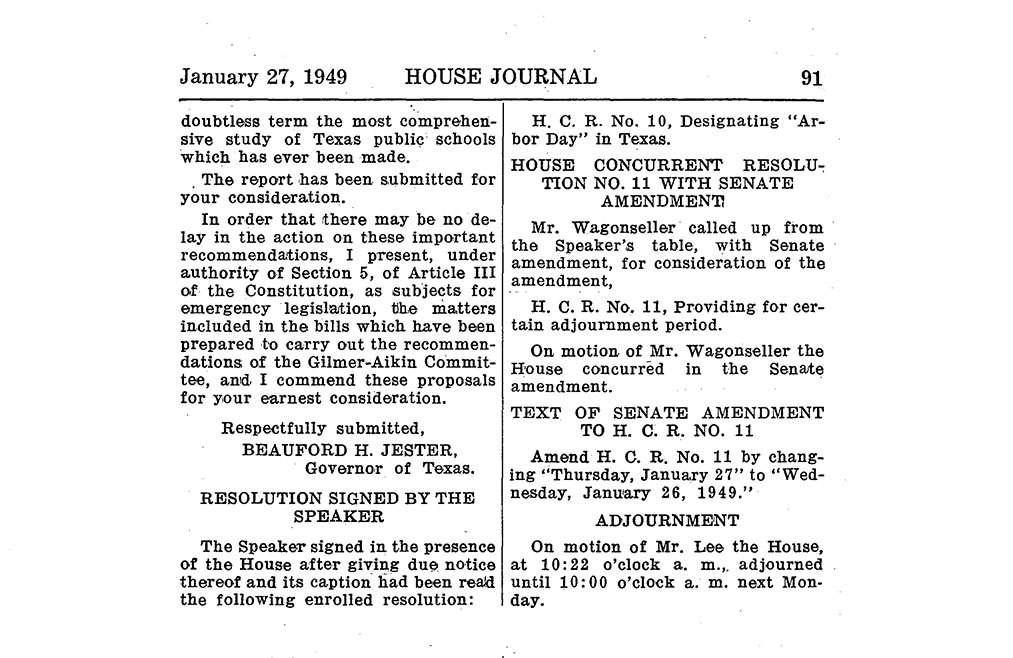
Did you know that the Texas Constitution prohibits the House and Senate from passing legislation during the first 60 days of a regular legislative session? That is—unless either chamber suspends the rule by a vote of four-fifths of its membership, or if the legislation is an appropriation or other matter declared by the governor to be an emergency. This is part of the order of business set out by Article 3, Section 5, of the Texas Constitution. What constitutes an "emergency"? Anything that the governor wants to be prioritized in that year's session, or any issue the governor wants to support. If a bill is related to a governor's emergency item, members can decide to vote on it earlier in the session.
To take best advantage of that 60-day head start permitted by the emergency designation, the items typically are submitted early in session. Emergency items are ideally matters that could be addressed in the first few months of session. However, the governor can submit emergency items at any time throughout the session. Due to a prohibition in the house rules against considering other bills making an appropriation before the general appropriations bill has finally passed, emergency items submitted by the governor after the first 60 days of a regular session typically relate to appropriations for specific purposes. For example, Gov. William P. Clements submitted two emergency appropriation matters to the 66th Legislature following major tornadoes in Wichita Falls and the surrounding area (filed on April 26, 1979, and May 2, 1979).
Recent emergency matters include legislation relating to transportation, abortion, wildfire damage and recovery, and much more. You can explore a listing of emergency items dating from the 38th session (1923) to the 84th (2015) via the library's governors database.
Images:
House Journal, 51st R.S. (1949): Governors have used emergency items in different ways over the years, resulting in some submitting items more frequently than others. Govs. Beauford H. Jester and William J. Clements both submitted about 50 emergency items, but Jester spent just two years in office (an average of 25 items/year) and Clements served for a total of eight years (an average of 6.25 items/year). In this 1949 emergency item, Jester hails the work of the Gilmer-Aikin Committee and encourages the Legislature to support its educational reform recommendations.
Senate Journal, 43rd R.S. (1933): In March 1933, Gov. Miriam (Ma) Ferguson issued a general proclamation/legislative message declaring a bank moratorium in an attempt to address the growing financial problems of the Great Depression. Her decree was sustained a few days later by President Franklin D. Roosevelt's declaration of a national bank holiday (with federal guidelines).
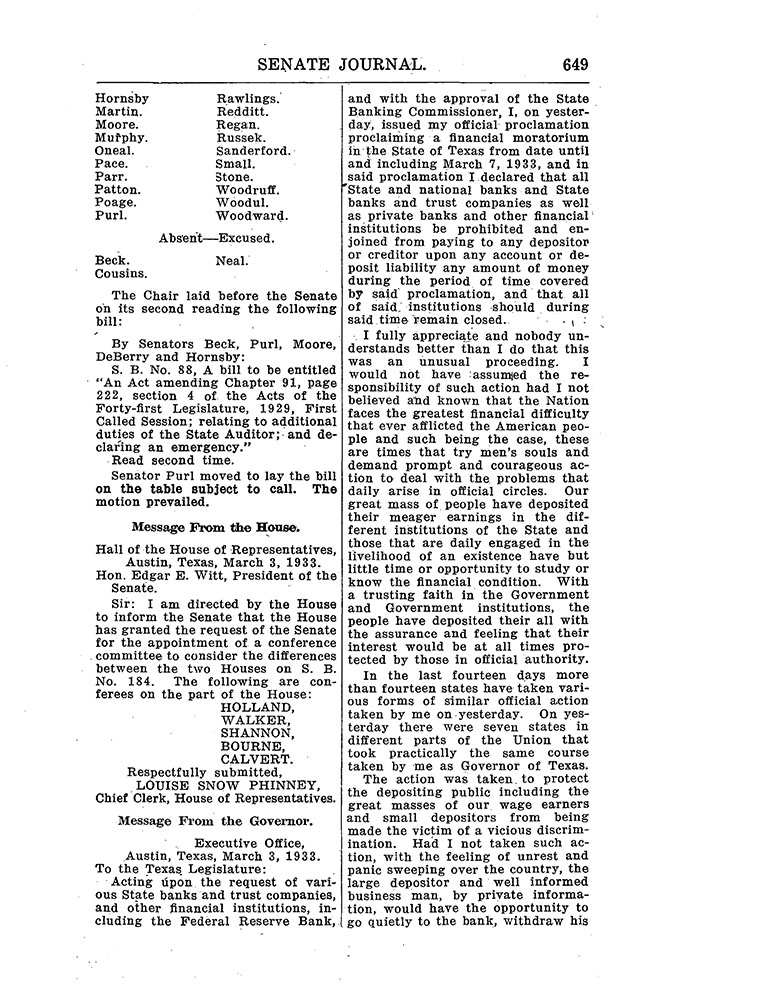
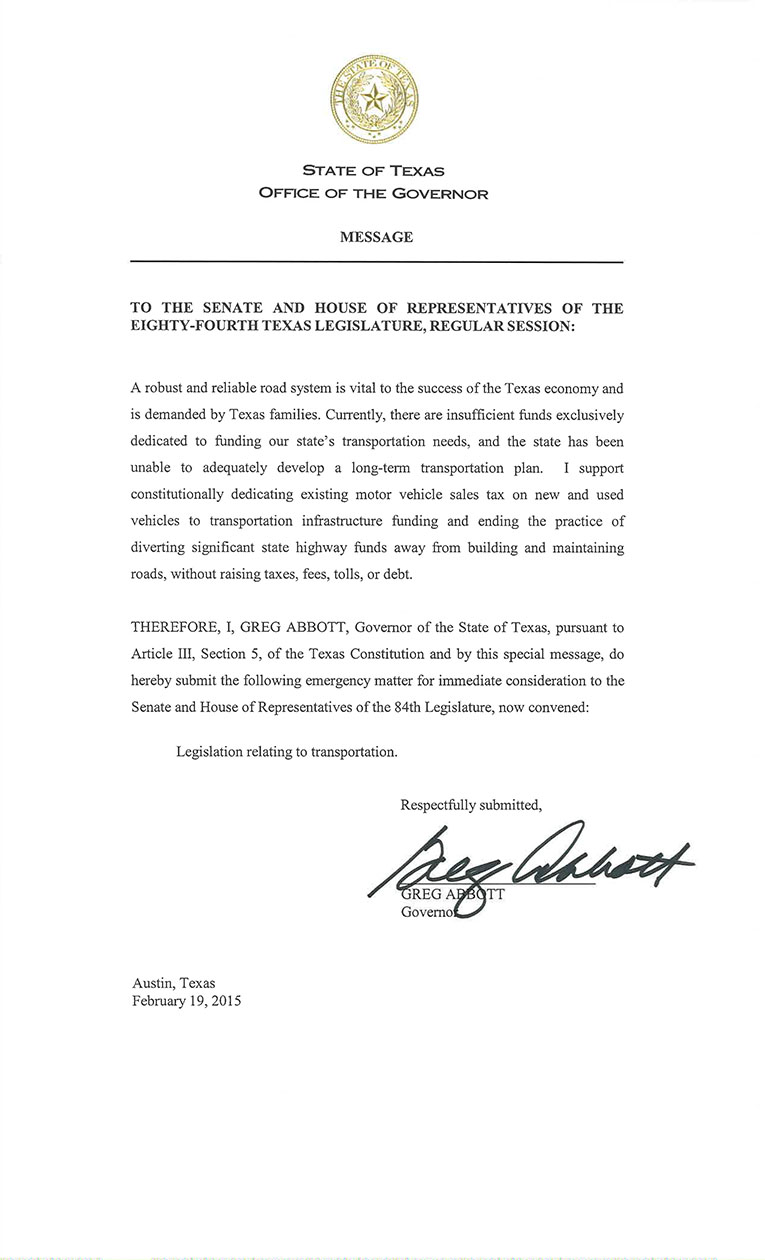
On January 20, Greg Abbott will be sworn in as Texas' 45th governor.
Like his predecessors, he will deliver an inaugural address to a joint session of the House and Senate, and festivities will be held throughout the day to celebrate his inauguration.
To commemorate this event, the Library has prepared a new exhibit highlighting Greg Abbott's inaugural festivities, as well as those of former Texas governors Rick Perry, Ann Richards, and W. Lee 'Pappy' O'Daniel. Many of the items featured in the exhibit can be seen in our online collection of gubernatorial inauguration materials.
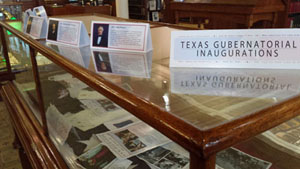
If you are interested in the work of past governors, the library's governor documents database is a good place to start. You can find things like:
- State budgets that past governors have proposed.
- Emergency matters that past governors have submitted to the Texas Legislature.
- Speeches delivered by past governors, including State of the State speeches and inaugural addresses.
- Executive orders of past governors.
- Bills vetoed by past governors.
If you're looking for something specific and are unable to find it, the library can provide further assistance. Please contact us at (512) 463-1252.
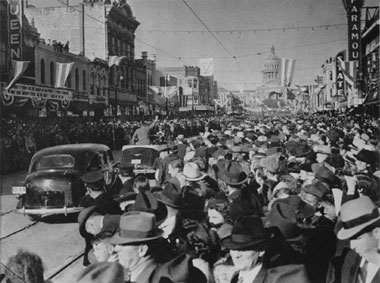
A photo from the exhibit showing Congress Avenue during the inauguration of W. Lee 'Pappy' O'Daniel in 1939.
A recent article by the Sunlight Foundation evaluated all 50 states on the accessibility of their governor's executive orders. Texas earned an A, scoring high marks in categories such as machine readability, use of non-proprietary formats, availability of executive orders for current and prior administrations, and timeliness of availability (how quickly executive orders are posted after they are issued).
While the study focused on the executive orders available through Gov. Perry's site, it's worth noting that the library has an extensive collection of Texas executive orders, and has made them available online through our Governor Documents database. You'll find all executive orders from Gov. Rick Perry, as well as those in our collection from previous governors. Our oldest executive order dates to 1950 (Gov. Robert Allan Shivers), and concerns state disaster relief and civil defense.
While you're exploring the executive orders, it might interest you to take a look at some of the other documents available in the database, including disaster declarations, 2001-present, and emergency matters submitted in past legislative sessions.
The library is pleased to announce a new online collection of gubernatorial inauguration materials. Inauguration of a Texas governor is often celebrated with receptions, parades, galas and barbeques. Over the years, the LRL has accumulated a collection of material related to these events, including invitations, programs and tickets. These unique items are now available on our website. The collection features items from the Legislative Reference Library as well as items from private collections and from the Texas State Library and Archives.
The oldest pieces in the collection are an invitation and brochure to the 1891 inauguration of Governor James S. Hogg.
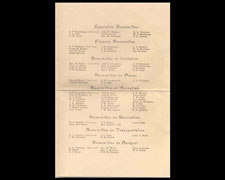
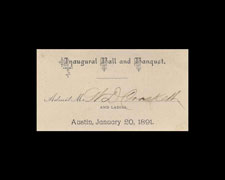
More recent inaugural materials provide a detailed look at inaugural events, as well as information about the committees that planned the events. You'll also find unique items like the transcript of Governor W. Lee O'Daniels' 1941 radio broadcast inviting Texans to the inauguration ceremony and a free barbeque (below left), and a brochure for the inaugural special train that was part of Governor Beauford Jester's ceremonies (below right).
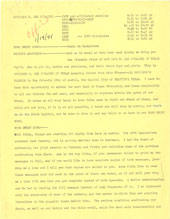

Some governors chose themes for their inauguration ceremonies, such as Governor George Bush, whose inaugural theme in 1995 was "What Texans Can Dream, Texans Can Do," and in 1999 was "Together We Can / Juntos Podemos."
Governor Rick Perry recently announced that he will not seek re-election in 2014, leaving an open race for Texas governor in which the incumbent is not running. The last open race for Texas governor occurred in 1990, when Governor Bill Clements did not seek re-election. We examined records going back to the first Texas primary in 1906 to see which other open races for governor have occurred.
|
Election
|
Incumbent governor
|
Winner
|
| 1990 election | William P. Clements | Ann. W. Richards |
| 1968 election | John B. Connally, Jr. | Preston Smith |
| 1956 election | Robert Allan Shivers | Price Daniel, Sr. |
| 1946 election | Coke R. Stevenson | Beauford H. Jester |
| 1938 election | James V. Allred | W. Lee O'Daniel |
| 1934 election | Miriam Ferguson | James V. Allred |
| 1930 election | Daniel J. Moody, Jr. | Ross S. Sterling |
| 1924 election | Pat M. Neff | Miriam Ferguson |
| 1920 election | William P. Hobby | Pat M. Neff |
| 1914 election | Oscar Branch Colquitt | James E. Ferguson |
| 1910 election | Thomas Mitchell Campbell | Oscar Branch Colquitt |
| 1906 election | S.W.T. Lanham | Thomas Mitchell Campbell |
Election information obtained from the Texas Almanac.

